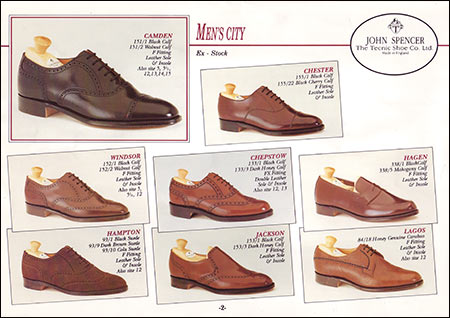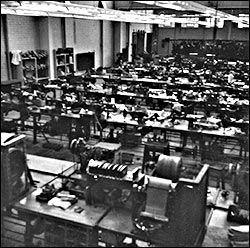|
||||
| Memories of Ron Hunt |
||||
|
Working Life at The Tecnic Shoe Factory 1939-1986
|
||||
|
||||
|
Ron left
All the factories in the area would close for set holidays in the summer and Easter and at Christmas, and then the bank holidays were all amalgamated together to make a week in September. Rushden High Street would be 'dead' during factory fortnight. The most popular holiday resort for the workers would be
Some of the employees from the factory set up their own sports and social clubs. Ron played in the darts team and also played cricket against other local factories’ teams. For a few years the Tecnic organised annual dinners at the Windmill Club in Rushden. Ron was employed at the Tecnic shoe factory for all his working life, a total of 47 years. He had a break for just over 3 years when he was called up to join the Royal Navy during the Second World War. Upon his return he was more or less guaranteed work of some kind within the factory. Ron’s first job at the factory was on 'toe puffs' – these were used to stop the toe of the shoe from sagging. Then, when he was about 17 years old, he moved on to 'riveting' - this joined the soles to the seats. He also did bottom filling – putting cork in to get the soles to lie flat, and 'bottom rolling' – this was done on a machine to shape the shoe. Eventually Ron moved on to 'stitching'. This was a very skilled job, with more responsibility. He stayed on this job for the remainder of his employment. On reflection, Ron felt that he could probably have earned more money doing piece work on an unskilled job. The price structure was not really that fair. However, he belonged to the Boot and Shoe Union, who did at least try to negotiate rates and better conditions for its members. The factory had two ways of calculating pay – Day Work – when the person was just paid a flat rate per hour and – Piece Work – when so much was paid for every dozen pairs of shoes. This last method could pay out more depending on how fast the person worked, but there was only a marginal difference in the wage packet at the end of the week between either rate. In 1943 the day rate for a man was £2. 14 shillings. (£2.70) The process of shoe making in the factory commenced in the 'Clicking Room' where the uppers of the shoe were cut out of the leather with the use of a pattern. This was carried out by skilled clickers.
The Tecnic shoe factory was built in the late 1920’s, and the room where Ron worked stitching, was added on later in about 1939. So he had quite good working conditions compared to many older factories in the town. One advantage being that is was all on the one floor, whereas some were several storeys high and even had rooms below ground level. About 150 employees worked in the factory. There were at least 50 in Ron’s room. Separate offices were adjoining. The toilet facilities were very basic and there was only cold tap water for years until eventually a hand wash water heater was installed. The factory was first heated by hot water pipes, but later gas heating was installed in the roof. There were fans for in the summer and Ron had the advantage of working beside a door that he could also open for a through draught. It would still get very hot and sticky at the peak of summer. It was very noisy with a lot of machines running in the room and of course there was the strong aroma of new leather always pervading. Some of the machines were owned by the factory, but most were on lease from The British United Shoe Company. They would send their own mechanics to maintain them. A tea lady was employed and she took it round to the employees at their machines. No actual tea-break was allowed. Ron stood at his machine all day. There were at one time as many as three men on that job, but this eventually dwindled down to just himself. He could stitch up to 500 pairs of shoes a day. They came to him on racks; there were no conveyor belts in the factory. The factory produced both men and ladies shoes, in either welted or stick on soles. They also made boots for the police and R.A.F etc. During the war shoes were specially made for people who worked in munitions. These were not allowed to contain metal in them. The factory did not produce high heeled shoes or top fashion designs, just styles for practical use. Later on huge quantities of golf shoes were made. One famous golfer, Nick Faldo was paid a £1 for every pair sold with his name on. Ron certainly had to work harder for his pound’s worth! The Tecnic manufactured shoes to order for various well known brand names at that time. ‘Lilley and Skinner’, ‘Clarke’s’, ‘Leonard’s’, ‘Kay’s’, 'Benefits’ of Bedford to name but a few. Some had their own logo printed on the shoe. The export trade was also very lucrative to such places as the Trade was badly affected in the 1970’s due to the coal miners’ strikes that affected the whole country, causing the electricity stations to ration supplies. The Tecnic workforce was put on a ‘three day week’. This actually meant that the employees worked three days on and four days off including weekends. They obviously received less of a wage during that period. Eventually in about the1980’s cheap foreign imports of shoes to this Country eventually brought the demise of the local shoe factories. People would pay less for a poorer quality of shoe and buy a new pair when they wore out rather than pay higher prices for a pair that would last and could also be repaired. Fashion shoes rather than practical became the norm and then the trainer style really sealed the fate of such factories as the Tecnic Shoe Company. In fact from a town that was practically built up due to the shoe trade in the 1800’s, by the year 2006 only three shoe factories remained in Rushden and the last tanning/leather factory had closed. Although the work was very repetitive and often frustrating especially in the latter years due to bad management, Ron considered that on the whole he had been reasonably contented to earn a regular wage locally. In that era it was what the majority of people did anyway as Rushden was one of the largest shoe manufacturing towns in the Country.
|
||||

